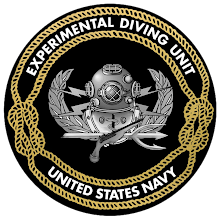Navy Diving traces its roots back to the late 1800s as a collateral duty for Gunners Mates. This was mostly to support the recovery and development/testing of a new weapon of naval warfare known as the torpedo. Back then divers were simply instructed in things like how to dress out and hand crank an air pump as the program was in its infancy (any sort of diving science didn't exist). In these very early years of development the Navy's diving community mirrored that of the torpedo in many ways. This article will discuss a bit about both with focus on the Keyport, WA area. If you have ever been involved in diving in any way, shape or form and get the opportunity to visit this area; you will find some of the richest diving history out there - even if you were to exclude the undersea museum.
In the late 1800s the Navy was developing a weapon that would revolutionize warfare called the torpedo (then called a mine). As with any warfare device, it required extensive development and testing. Testing would be conducted at a controlled underwater range and test torpedoes would need to be recovered to see what went right and wrong with them; this signaled the Navy's first need for a diver. The Navy's first torpedo range was established in Newport, Rhode Island in late 1869. Soon there after, the Navy established its first diving school under Chief Gunners Mate Jacob Anderson to recover torpedoes in 1882. At the turn of the century, high demand for the torpedo and difficulty in getting them to the west coast showed need for a west coast torpedo station. In 1908 a special task force of officers was sent to the west coast to scout for a clear water site that had sandy bottoms, little tide and depths between 30 and 60 feet. This task force would search areas such as San Diego, Los Angeles, Tacoma and British Columbia. In 1913 the Navy would settle on a little populated peninsula that had recently been named Keyport, WA. The few Keyport land owners that existed did not want to sell to the Navy - for any price. Once condemnation proceedings were complete; each land owner was given a share of a $60,850 pot of money. The Pacific Coast Torpedo Station (PCTS) would be officially commissioned on November 11, 1914 although the base remained to be built. Building #1 would be completed in 1916 and base construction would quickly move forward from there.
The sixth building to be constructed was the base chapel but would not remain as such for long; it would be converted to the Diving Locker after a few years - no I'm not kidding. This coupled with a chamber room addition is what you see today. In 1919 Keyport would hold its first diving class (8-9 enlisted) under Chief Mickey Nolan. Again, in these early years of diving there were no safety procedures like we have today. It was common practice for divers to complete their job, fully inflate their suit and jet to the surface. This stopped after a few years of "strange unknown sickness" occurring in divers (likely the bends or a gas embolism). Initially there was no chamber in Keyport with the closest one being in British Columbia. Because time was at a premium to treat diving illness, those afflicted would usually be suited up and lowered into the deepest possible area, usually off Seattle (200fsw). The Keyport area would not have a chamber until one was built for them in the 1930s. This chamber was constructed at the Norfolk Navy Yard and is said to contain over 600 rivets - easy to believe for its sheer size (it has been nicknamed "The Whale"). The truly unique thing about this chamber is it is still in use today making it far and away the oldest certified recompression facility in the military and certainly one of the oldest active in the world. Testing and retrieving torpedoes was very different in the 1940s than it is today. Back then, torpedo speed and depth measurements were made by a visual system consisting of barges set at each 1000 yard range. Observers on the barges would time the torpedoes as they passed to access speed. Originally, a rough visual estimate was used to determine the torpedoes depth and eventual recovery location. Later depth was determined with the use of nets placed on the range; the hole the torpedo made as they passed through would show its depth for a given distance. Recovery location was solved by placing smoke pots in the torpedo. When it sank, the smoke pot would send up a stream of bubbles to the surface making location much easier for Navy Divers.
Part II of this article will focus on one of the many outstanding Navy Divers who served many years at the Keyport Dive Locker - TMCM(MDV) Robert (Bob) Sheats. His career is as impressive and varied as any in Navy history. Any write-up that showcases the history of the Keyport Diving program would simply be incomplete without including him. Below is a hyperlink that has a great detailed write-up about the development of what would be nicknamed "Torpedo Town, U.S.A." The first hyperlink is Chapter 6 which showcases its diving program - you will see a few old black and whites that include a short write up about Master Diver Sheats -- call it a sneak preview. The second hyperlink contains all chapters of the article.
http://www.hnsa.org/doc/torpedotown/chap6.htm
http://www.hnsa.org/doc/torpedotown/index.htm
Note: Earlier in this article, the Naval Undersea Museum (located at the Keyport Navy Base) was mentioned. If you are ever in the area, it is not to be missed. It contains diving displays such as the Trieste, the end bell of SEALAB II, diving equipment from its inception to present, torpedo and submarine exhibits to name just a few. Below is a hyperlink to the Undersea Museums website.
http://www.navalunderseamuseum.org/
H/Y


No comments:
Post a Comment